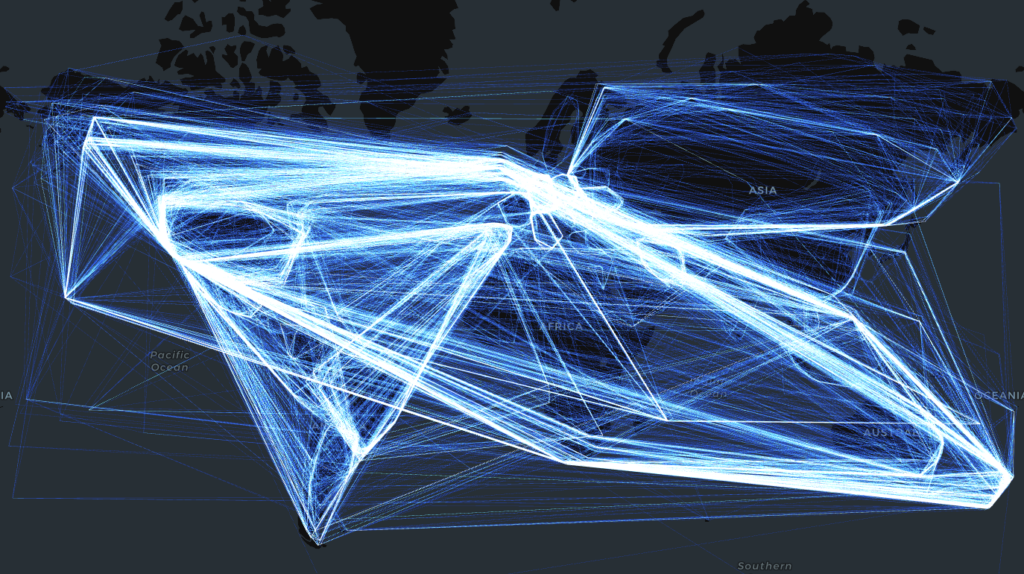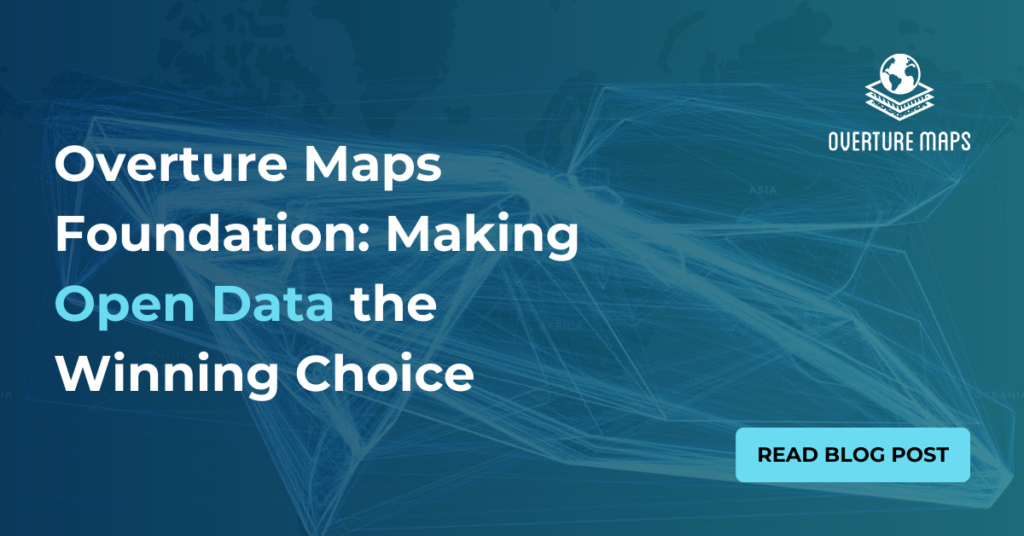Overture Maps Foundation (Overture) was formed in December 2022 to address a pressing need for reliable, interoperable open map data.
The vision was intentionally huge and transformative for the mapping industry, and, while much work remains to be done, the team has been making that vision happen, piece by piece. Over the past two years, Overture has made meaningful strides, delivering open map data that hundreds of millions of consumers use via Facebook, Instagram, Bing/Azure maps, Esri users in government and GIS, insurance providers, and more. I wanted to recap what we’ve accomplished together and share what’s ahead for 2025.
Year One, 2023: Why Overture?
The first year of Overture was about building the foundation for a long-term collaborative effort. This journey started by rethinking the fundamental challenges that face the geospatial industry. While proprietary databases offer high-quality data, they come with complex licensing and cost restrictions. Community-built open projects provide valuable data but can be challenging to use for commercial applications. Other open map data from corporations, nonprofits, and governments go unused because of the difficulty of integration and license incompatibility. And, while there is an explosion of new types of data that give us richer, more accurate applications, there is a corresponding explosion in the cost and complexity of integrating that data. It is not uncommon for companies to spend more on processing and conflating data than they do on licensing it.
We formed Overture to address these challenges through collaboration.
To make this vision real, we focused on three key elements:
- Combining the best available open data from community, government, and corporate sources into unified, open datasets.
- Enhancing data quality through validation and standardization to ensure interoperability.
- Making the data easy to use and to work with other data in map applications and spatial analysis.
Within months of our launch, we made a pre-release dataset — a proof of concept that demonstrated what we could achieve through collaboration. By July 2023, we began monthly releases of the worldwide dataset, still in beta but growing in maturity from month to month. We started with data “themes” for transportation, POls, buildings, and administrative boundaries. We later added a contextual theme with coastlines, land cover, and other data and then an open address theme.
We also started to think about how the data should be structured. In June, we introduced the Overture Data Schema and our Global Entity Reference System (GERS), fundamental components that would make our data more usable and interoperable. The schema provided developers with clear, intuitive rules for data representation, while GERS offered a way to uniquely identify and reference map features, allowing developers to link other spatial data directly to the underlying base map.
Our community grew beyond our founding members to include more than 20 organizations, including Esri, the market leader in location intelligence, as our first General Member. Each new member brought unique expertise and perspectives, enriching our collaborative approach to mapping. New working groups and task forces formed organically, tackling specific challenges.
By the end of the year, we had built more than just datasets — we had created a foundation for collaboration that would shape the future of open mapping. We were ready to move from initial organization to broader implementation.
Year Two, 2024: Laying the Foundation
2024 marked our transition from foundation-building to delivering production-ready data. In July of 2024, we reached a major milestone with our General Availability (GA) release, paving the way for new and expanded use cases for commercial mapping applications and geospatial analysis. The datasets covered four themes, buildings with 2.3 billion building footprints worldwide, 54 million places of interest, national and regional divisions, and contextual layers including land and water data.
The impact was immediate. By the time of GA, the data was already powering use cases in local discovery, insurance, and mapping industries: Meta integrated it into their social applications, Microsoft adopted it worldwide for Bing Maps, and Esri incorporated it into their ArcGIS Living Atlas. TomTom began incorporating our data into their Orbis Maps platform, while Addresscloud used our building data to provide insurers with flood-level risk metrics for individual buildings. Availability also increased with the Overture releases available in AWS and Azure upon release but also in data warehouses such as Snowflake, Google’s BigQuery, and Databricks for customers of those platforms. This GA release opened the gates for adoption by map developers and continuous feedback.
Alongside this, we launched our address initiative in July and have been steadily building that data. To date, we’re mapping over 400 million addresses across 34 countries — a crucial first step toward a comprehensive global address database. We also introduced visualization tools to make datasets easier to explore and download, enabling developers to better understand and work with our data.

A visualization of convex hulls grouping all roads with the same name in Overture.
Our membership grew significantly, from our original four founding members to 35 organizations across diverse sectors. Throughout 2024, we welcomed Niantic Labs, AddressForAll, GlobalLogic, CARIAD, Camptocamp, TripAdvisor, NAVIS-AMS, NDrive, Kaart, Humanitarian OpenStreetMap Team (HOT), Wherobots, Grab, Krick, Fresno County, e Foundation, Crunchy Data, and Intellias Global Limited. These new members represent a remarkable breadth of expertise—from automotive innovation to humanitarian mapping, from local government to global technology leaders. This diverse expansion reflected growing recognition that open map data could serve as a foundation for innovation across industries and communities.
The year concluded with the second significant achievement. In December, we released our Transportation dataset to general availability, mapping 86 million kilometers of roads worldwide. This complex dataset included detailed traffic rules and restrictions, comprehensive rail and ferry route information, and a linear reference system for precise location referencing.
Harder to see externally, we also made significant progress in our technical infrastructure. Our teams worked to transition data pipelines from member companies to Overture’s own infrastructure, moving toward platform independence. This shift represented more than just technical progress — it demonstrated our members’ commitment to true collaboration and openness, ensuring that our infrastructure could serve the entire mapping community regardless of their technical preferences.
Year Three, 2025: Data for Everyone
As we enter 2025, our focus shifts to widespread adoption and ecosystem growth. Our key priorities include:
- Improving Places Data: No one in mapping has fully solved the challenge of ensuring accurate, up-to-date, data on places. Why? Places change. Businesses open, close, move, etc. Overture’s community can solve this. As Overture’s community of contributors collects information, it will help keep datasets up to date.
- Driving GERS Adoption: The amount of data in the world is exploding and it needs to be organized so that it can be used. In Overture, that mechanism is GERS. Stable identifiers are not new in mapping, but GERS is unique because it is global, open, and entity-based. These three characteristics, Overture believes, will entice the global mapping community to coalesce around GERS because it ensures that the right data gets attached to the right place, making all data more useful. In the coming year, Overture will refine GERS so that external data sources, such as weather, traffic, population, etc., see Overture as the map they want to link data to.
- Completing Pipeline Migration: To date, two-thirds of the data that migrates into Overture travels via pipelines that Overture has built and maintained, not member companies. By 2026, all will be Overture maintained. This foundational work represents a significant step forward, not just for our technical capabilities but for our mission of creating open, scalable map data.
- Continual Data Quality Improvement: Overture will establish more metrics for data quality, make them transparent, and continually improve its datasets.
- Creating New Data: New data, via the internet, contributors, and AI agents, will enrich datasets. AI agents, for instance, may create purpose-built data sets.
- Focusing on Key Areas: Overture will support applications in government, automotive, logistics, and ride-sharing industries while exploring opportunities in humanitarian and climate-related projects.
Building the Future Together
Map data has become as essential as electricity in our daily lives, quietly powering countless services we rely on. From helping delivery drivers find optimal routes to enabling emergency responders to reach their destinations, map data underlies critical services across industries and communities.
Over the past two years, Overture has built a strong foundation for open, interoperable map data. From launching core concepts such as GERS to delivering production-ready datasets, Overture has demonstrated the power of collaboration in addressing global mapping challenges. As we look ahead to 2025, we remain committed to enabling innovation, supporting diverse industries, and fostering a vibrant community of users and contributors.
By the end of 2025, we aim to make open map data the preferred choice for developers, governments, and businesses worldwide, driving innovation and collaboration across sectors.
The future of mapping is open, collaborative, and built together. Join us in making it happen. Visit our website to learn more about our work, and become a member.
Stay connected: follow us on Linkedin, X, and Bluesky for the latest updates. Sign up for Overture’s monthly newsletter for exclusive updates on our technical progress and community initiatives.

